The way we define ourselves as Americans has always been fluid. But something different is happening right now. Digital culture isn’t just changing how we communicate—it’s rewriting the very foundation of what it means to belong, to create, and to be seen in America.
We’re living through a massive cultural shift that historians will study for decades. The internet didn’t just give us new tools. It gave us new ways to form identities, build communities, and express values that have nothing to do with where we were born or who our neighbors are.
Understanding Digital Culture in Modern America
Digital culture refers to the social behaviors, norms, values, and forms of expression that emerge from our daily interactions with technology and online platforms. It’s not just about being online. It’s about how being online has fundamentally changed who we are offline.
Think about it this way: your grandparents formed their identity through their neighborhood, their church, and their workplace. Your parents added television and long-distance phone calls to that mix. But your identity? It’s probably shaped just as much by Reddit communities, Instagram aesthetics, TikTok trends, and Discord servers as it is by your physical location.
This isn’t shallow. This is profound. Digital culture has created entirely new frameworks for American identity that exist independently of traditional markers like geography, ethnicity, or socioeconomic class.
From Melting Pot to Global Feed: Digital Culture and Community Formation
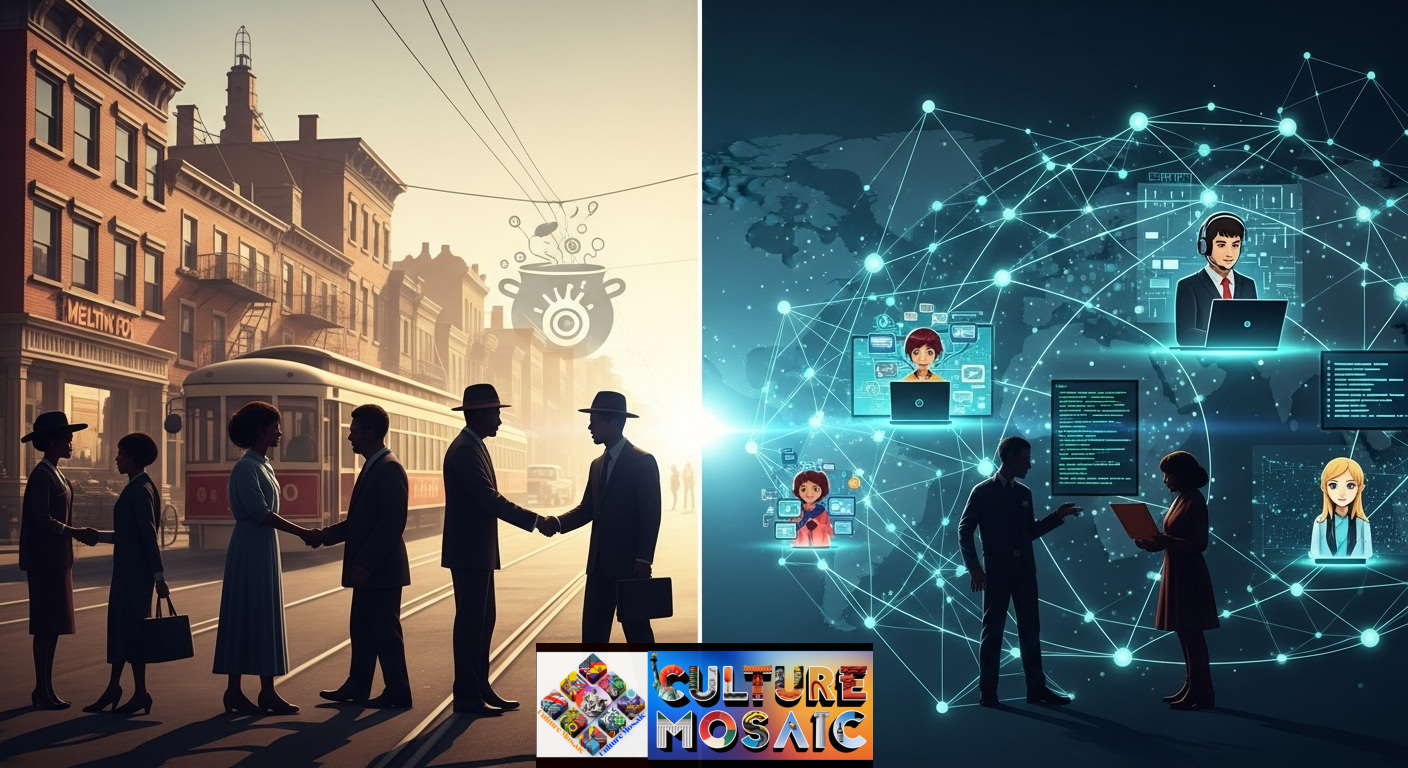
The American melting pot was always about physical proximity. Immigrants arrived in cities, settled in neighborhoods, and gradually their cultures blended with their neighbors’. Community meant the people you could actually see and touch.
Digital culture has exploded that model completely.
Now, a teenager in rural Montana can find their community among anime fans worldwide. A Black programmer in Atlanta connects more deeply with other coders on GitHub than with people on their street. A second-generation immigrant maintains stronger cultural ties through WhatsApp groups and YouTube channels than through local ethnic enclaves.
This shift has created something unprecedented: identity based on chosen affinity rather than inherited circumstance. Digital culture allows Americans to curate their communities around shared interests, values, and experiences rather than defaulting to whoever happens to live nearby.
The implications are staggering. Traditional institutions that relied on geographic community—local newspapers, neighborhood associations, even political parties—are struggling because digital culture has given people alternatives. You don’t need the local paper when you have Twitter. You don’t need the neighborhood watch when you have NextDoor. You don’t need political parties when you have decentralized online movements.
The Attention Economy: How Digital Culture is Rewriting American Values
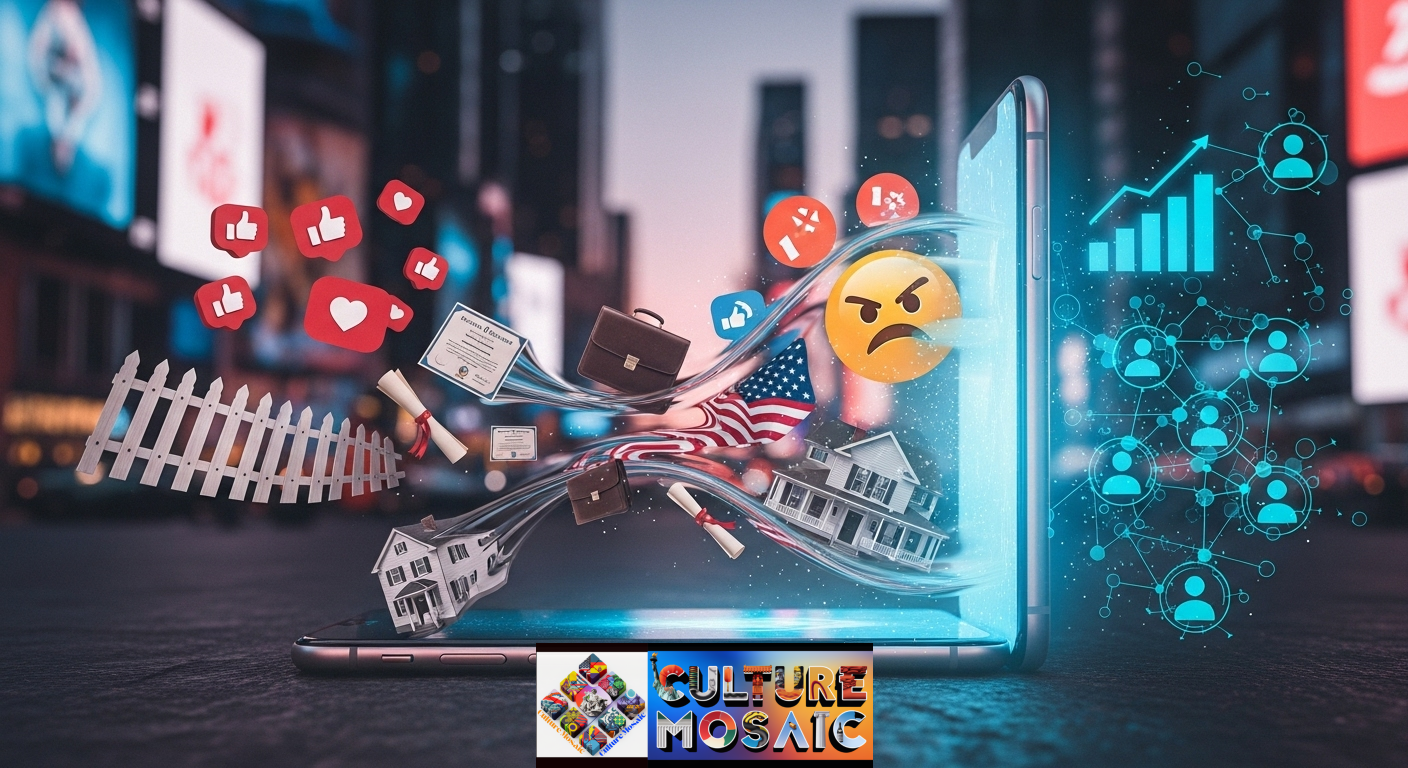
Digital culture operates on a currency that previous generations never had to think about: attention. And the platforms that mediate digital culture have turned attention into an economic and social system with its own rules.
Algorithms don’t care about what’s true or meaningful. They care about what keeps you scrolling. This fundamental mechanism is reshaping American values in real time.
Consider outrage. It spreads faster than nuance because digital culture rewards emotional intensity. Consider performance. We present curated versions of ourselves because digital culture measures worth in likes and followers. Consider tribalism. We sort ourselves into ideological bubbles because digital culture’s recommendation systems feed us more of what we already believe.
These aren’t bugs in the system. They’re features that digital culture has baked into modern American life.
The attention economy has also created new hierarchies of status. Traditional markers of success—a nice house, a stable job, a college degree—matter less in digital culture than they did for previous generations. Now, influence is the currency. A 22-year-old with three million TikTok followers has more cultural capital than most CEOs. A YouTuber explaining makeup techniques reaches more people than most professors ever will.
This isn’t trivial social commentary. The attention economy of digital culture is actively redistributing power, influence, and economic opportunity in American society. And we’re only beginning to understand what that means.
The Creator Class: Digital Culture and the New American Dream
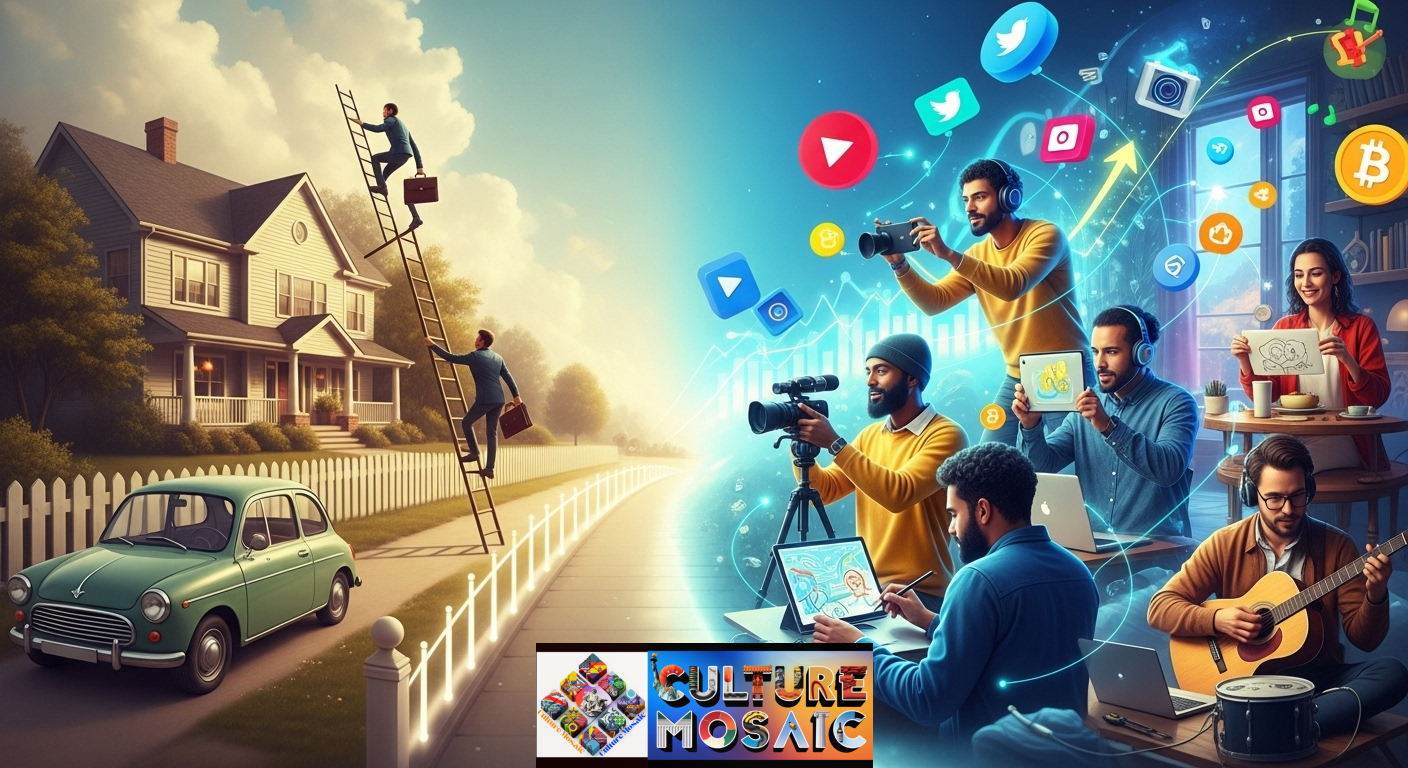
The American Dream used to be pretty straightforward: work hard, climb the corporate ladder, buy a house, and retire comfortably. Digital culture has introduced an entirely different vision: build an audience, monetize your passion, work from anywhere, answer to no one.
The creator economy is one of the most visible manifestations of how digital culture is transforming American identity and aspiration. Millions of Americans now make income through platforms like YouTube, Twitch, Patreon, Substack, and OnlyFans. But more importantly, millions more see this as a viable path—maybe the most viable path—to success.
This represents a fundamental shift in how Americans think about work, value, and self-determination. Digital culture has democratized fame and influence in ways that were impossible before. You don’t need a studio contract, a book deal, or a gallery showing anymore. You need a camera, an internet connection, and something interesting to say.
The creator class embodies values that feel distinctly American: entrepreneurship, self-reliance, authenticity, and individual expression. But it’s American identity remixed for digital culture. The medium is different, but the aspiration toward self-made success remains recognizably American.
What’s fascinating is how digital culture has made niche expertise valuable. You don’t need to appeal to everyone anymore. You just need to appeal intensely to someone. Creators are making six figures talking about fountain pens, explaining tax law, or ranking fast food chains. Digital culture rewards specificity and authenticity over broad appeal.
This shift has implications beyond individual success stories. As more Americans build identities around being creators rather than employees, it changes everything from healthcare needs to housing preferences to political priorities.
Virtual Reality is Real: Digital Culture Blurs Online and Offline Life
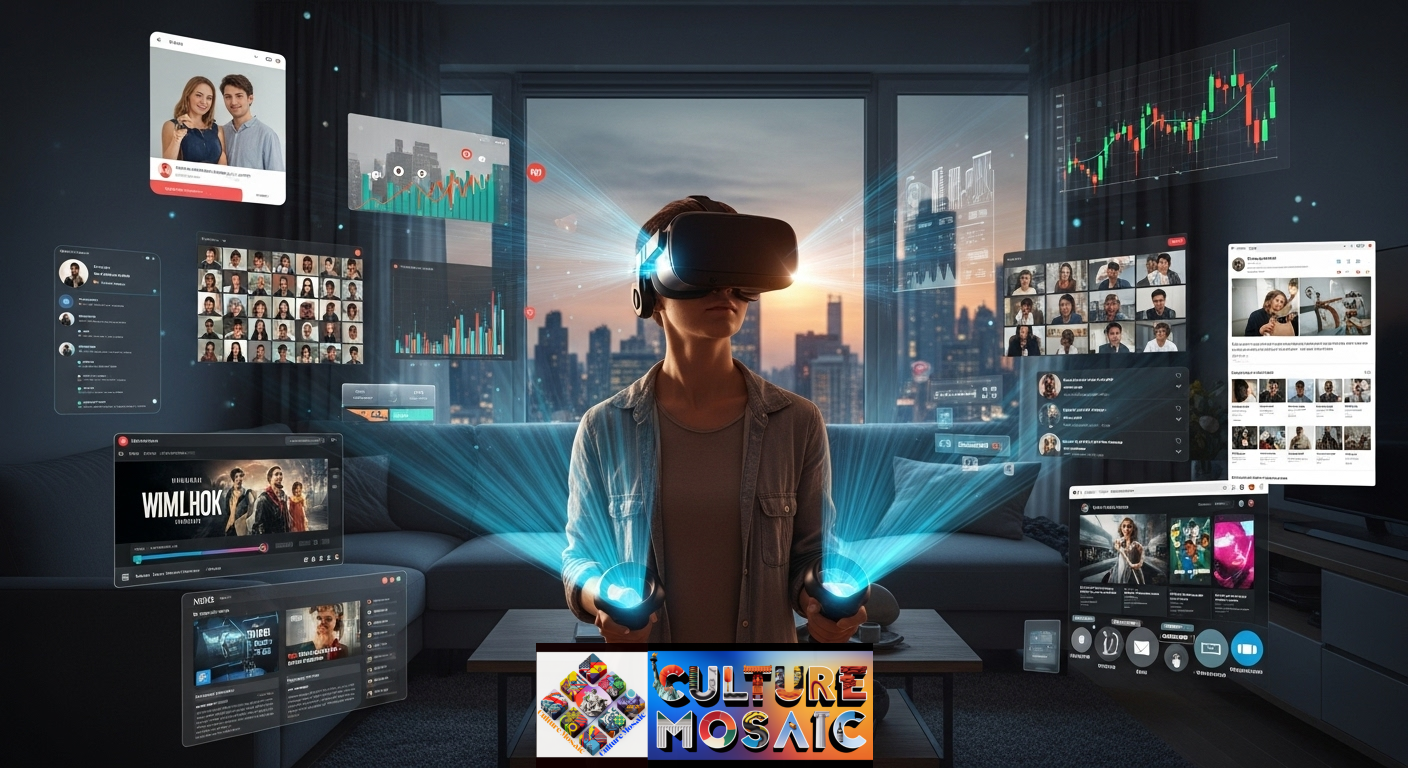
Here’s something that would sound absurd to someone from 1995: the distinction between online life and real life has essentially collapsed. Digital culture isn’t a separate realm we visit. It’s woven into every aspect of daily American existence.
Your relationship started on a dating app. Your money exists as numbers in an app. Your job happens in Zoom meetings. Your social life unfolds in group chats. Your entertainment is streaming. Your news is social. Your shopping is e-commerce. Your community is Discord.
At what point do we stop calling this “virtual” and just call it “reality”?
Digital culture has created hybrid experiences that don’t fit neatly into old categories. When you attend a concert in Fortnite with ten million other people, is that less real than a physical concert? When you make genuine friends in an online gaming community you’ve never met face-to-face, is that friendship less valid? When you buy digital art as an NFT, is that less real than buying physical art?
Americans under 30 don’t even ask these questions anymore. For them, digital culture doesn’t blur the line between online and offline—there never was a line to begin with.
This has profound implications for American identity. Our sense of place, presence, and connection has fundamentally changed. You can be simultaneously in Kansas and in a virtual space with people from six continents. You can have meaningful relationships with people you’ve never physically met. You can participate in communities, movements, and moments without ever leaving your room.
Digital culture has made American identity less tied to physical space than at any point in history. This creates opportunities—but also challenges around isolation, authenticity, and what it means to be present.
Cryptocurrency, NFTs, and Digital Ownership in American Culture

Digital culture isn’t just changing social interaction. It’s reimagining fundamental concepts like money, property, and ownership.
Cryptocurrency represents a distinctly American impulse within digital culture: distrust of centralized authority and faith in technological solutions. The idea that you can have money that exists independently of government or banks appeals deeply to libertarian strains in American thought. Digital culture has taken that abstract idea and made it tangible (or as tangible as digital things get).
Whether or not crypto succeeds as currency, it’s already succeeded as culture. It’s created communities, vocabularies, values, and identities. People call themselves “Bitcoin maximalists” or “Ethereum believers” with the same conviction that previous generations brought to political parties or religions.
NFTs took this further by asking: What does ownership mean in digital culture? If I own a digital image, what exactly do I own when anyone can screenshot it? These questions matter because digital culture is where Americans increasingly live. As more of our lives, relationships, and expressions happen digitally, questions about digital ownership become questions about real ownership.
The American response to these questions reveals something about how digital culture intersects with deeper American values around property rights, individual ownership, and market solutions to social problems.
Social Media Algorithms and the Fragmentation of American Reality
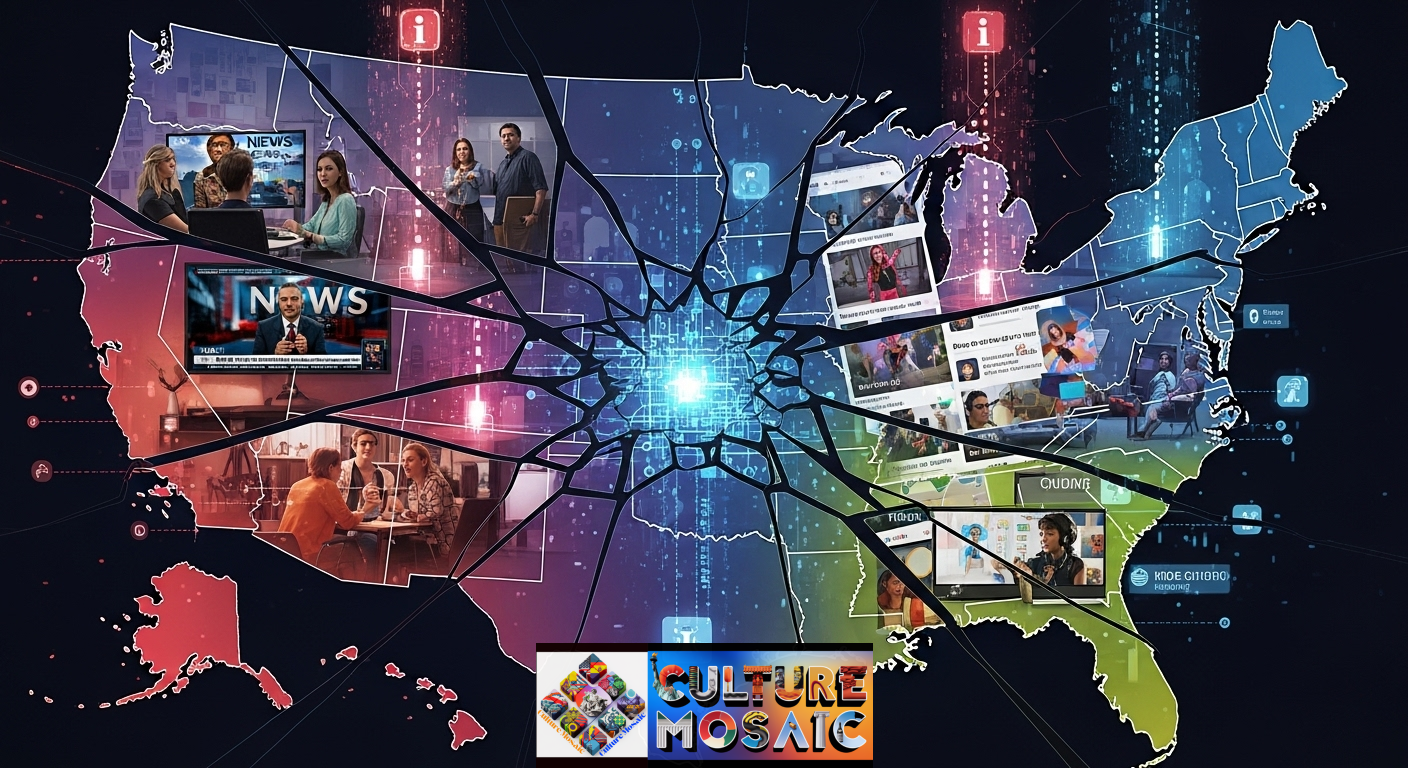
Perhaps nothing about digital culture has more profoundly impacted American identity than algorithmic content curation. We don’t all see the same news, consume the same culture, or live in the same information environment anymore.
Your Facebook feed is different from mine. Your TikTok For You page shows you different videos than anyone else sees. Your YouTube recommendations lead you down paths uniquely tailored to your viewing history. Digital culture has created personalized reality tunnels for every American.
This has shattered the concept of shared culture that previous generations took for granted. There’s no equivalent to everyone watching the same three TV channels anymore. Digital culture has replaced mass culture with micro-cultures, niche communities, and algorithmic filter bubbles.
The implications for American identity are profound. How do we maintain national cohesion when we don’t share a common cultural foundation? How do we have productive disagreements when we can’t even agree on basic facts because our algorithms feed us different information?
Digital culture has made it possible to live in parallel Americas that barely intersect. This isn’t just about political polarization, though that’s part of it. It’s about fundamental fragmentation of shared experience. Two Americans can live in the same city, speak the same language, and inhabit completely different cultural realities shaped by their algorithmic feeds.
This raises urgent questions about the future of American identity itself. Can national identity survive digital culture’s tendency toward fragmentation? Or will digital culture inevitably lead to further fracturing of American society into tribal subgroups with little common ground?
Digital Culture and the Evolution of American Language
Language has always evolved, but digital culture has accelerated that evolution dramatically. The way Americans communicate has been transformed by the constraints and affordances of digital platforms.
Character limits on Twitter created new forms of concision and wit. Memes became a visual language with its own grammar and cultural references. Emojis added emotional nuance to text-based communication. Acronyms like “LOL,” “IMO,” and “TBH” moved from chatrooms to everyday speech. Gen Z invented an entirely new vocabulary through TikTok that older Americans struggle to understand.
This linguistic evolution is a visible marker of how deeply digital culture has penetrated American identity. The way you communicate signals which communities you belong to and which generation you’re part of. Your fluency in digital culture’s linguistic innovations becomes a form of cultural capital.
But it’s more than just new words. Digital culture has changed the structure of American communication. We speak in threads, comments, and replies now. We communicate through reactions and shares as much as through original expression. We’ve developed new norms around response times, read receipts, and online availability that would baffle someone from 20 years ago.
Language has always been central to identity, and digital culture’s impact on American language reflects its impact on American identity itself.
Remote Work and Digital Culture’s Impact on American Life
The COVID-19 pandemic accelerated a trend that digital culture had been building toward for years: the decoupling of work from place. Millions of Americans discovered they could do their jobs entirely online. Many never want to go back.
This shift has massive implications for American identity and culture. When your job doesn’t tie you to a location, where do you live? When you interact with coworkers only through screens, what happens to workplace culture? When commuting disappears, how do we structure our days and define work-life boundaries?
Digital culture has made remote work technically possible, but it’s also created the cultural frameworks that make it socially acceptable. The same platforms that let us maintain friendships across distances let us maintain professional relationships. The same tools that let us consume entertainment digitally let us attend meetings.
For many Americans, digital culture has meant liberation from geographic constraints. You can live in a small town and work for a big city company. You can travel constantly while maintaining your career. You can optimize for quality of life rather than proximity to an office.
But this freedom comes with trade-offs. Digital culture’s facilitation of remote work has also enabled isolation, blurred boundaries, and the erosion of unstructured social interaction that happens naturally in physical workplaces. The long-term implications for the American community, mental health, and social cohesion remain uncertain.
Preserving Heritage: Digital Culture as Archive and Threat
Digital culture has created unprecedented opportunities for preserving and sharing cultural heritage. Family histories that once lived in shoeboxes now exist in searchable databases. Oral traditions get recorded and shared on YouTube. Immigrant communities maintain connections to their heritage through WhatsApp groups and streaming services that provide content in their native languages.
In this way, culture has been a powerful force for cultural appreciation. Americans with roots in other countries can maintain those connections more easily than any previous generation of immigrants. Digital culture makes hyphenated identities—Mexican-American, Korean-American, Irish-American—more sustainable because you’re not cut off from the first part of that identity anymore.
But digital culture also threatens cultural transmission in important ways. When knowledge exists online, we don’t need to learn it. When we can Google anything, we don’t need to remember anything. When cultural practices get reduced to viral TikTok trends, do they lose their deeper meaning and context?
There’s also the question of what gets preserved and what gets lost in digital culture. Digital platforms favor what’s easily captured and shared. Complex cultural practices, subtle knowledge, embodied traditions—these don’t translate easily to screens. Digital culture might be preserving some aspects of American heritage while inadvertently erasing others.
The question for American identity is whether digital culture ultimately enriches or impoverishes our connection to cultural heritage. The answer is probably both, in ways we’re still figuring out.
Digital Activism and Social Movements in American Culture
Digital culture has fundamentally changed how Americans organize, protest, and push for social change. Movements that once required physical organization now spread virally through hashtags and shares.
Black Lives Matter, #MeToo, March for Our Lives, and countless other movements gained momentum through digital culture’s ability to amplify voices, share stories, and coordinate action. Digital culture makes it possible to build awareness and pressure institutions in ways that were impossible before.
This represents a democratization of activism. You don’t need institutional backing or resources to start a movement anymore. You need a compelling message and the ability to capture attention in the culture’s attention economy.
But digital culture’s impact on American activism cuts both ways. The same tools that enable grassroots organizing also enable manipulation, disinformation, and performative activism that accomplishes little beyond making people feel engaged. Digital culture makes it easy to sign a petition or change your profile picture, but does that translate to meaningful change?
There’s also the question of sustainability. Movements built on digital culture’s viral dynamics can rise fast and fade just as quickly when the algorithm moves on to the next thing. Traditional community organizing was slower but often more durable.
Digital culture has made American activism more visible and accessible, but whether it’s made it more effective remains an open question. What’s certain is that it’s changed the landscape of social movements in ways that reflect broader changes in American identity and community formation.
The Dark Side: Digital Culture, Mental Health, and American Wellbeing
We need to talk about the costs. Digital culture isn’t just reshaping American identity—it’s impacting American mental health in measurable ways.
Rates of anxiety and depression, especially among young people, have risen dramatically alongside the rise of culture. The correlation isn’t proof of causation, but it’s hard to ignore. When we spend hours comparing our lives to curated highlights on Instagram, when our self-worth gets tied to likes and followers, when we’re constantly available and never truly disconnected, something suffers.
Digital culture has created new forms of social pressure and comparison that previous generations didn’t face. The validation loop of social media, the fear of missing out amplified by seeing everyone else’s experiences in real time, the performance anxiety of maintaining an online persona—these take psychological tolls.
There’s also the issue of culture’s impact on attention and presence. When we’re always partially engaged with our phones, are we ever fully present anywhere? When our brains get rewired to expect constant stimulation, what happens to our capacity for sustained focus or quiet reflection?
American identity has always included an optimistic faith in progress and technology. But digital culture is forcing a reckoning with that optimism. Maybe not every technological innovation makes us better off. Maybe some forms of connection actually leave us more isolated. Maybe efficiency and convenience aren’t always worth what we give up to get them.
This doesn’t mean rejecting digital culture entirely. It means recognizing that this massive shift in American life comes with genuine costs alongside its benefits. A mature relationship with digital culture requires acknowledging both.
The Future of American Identity in Digital Culture
So, where does all this leave us? What happens to American identity as digital culture continues to evolve?
The honest answer is we don’t know yet. We’re living through a transition period, and it’s always hard to see clearly from inside a transformation this large.
What we can say is that American identity has always been dynamic. Every generation has reinvented what it means to be American in response to new circumstances. Digital culture is just the latest chapter in that ongoing story.
But it’s a significant chapter. Culture is changing fundamental aspects of human experience—how we form communities, how we communicate, how we understand ourselves. The America that emerges from this transformation will look different from the America that preceded it.
The question isn’t whether digital culture will change American identity. It already has. The question is what we choose to preserve, what we’re willing to let go of, and what new forms of American identity we want to build.
Digital culture gives us unprecedented tools for connection, creativity, and self-expression. It also creates new vulnerabilities, inequalities, and challenges. How we navigate those tensions will determine what American identity looks like in the Digital Authenticity.
Frequently Asked Questions
How does digital culture shape who we are, and why does it matter?
Digital culture refers to the social behaviors, values, norms, and forms of expression that emerge from our interactions with technology and online platforms. It matters because it’s fundamentally reshaping how Americans form identities, build communities, and understand themselves. Culture isn’t separate from real culture—it’s become woven into every aspect of modern American life.
How has digital culture changed American identity?
Digital culture has shifted American identity from being primarily geography-based to being affinity-based. Instead of deriving identity mainly from where we live and who our neighbors are, Americans increasingly form identities around online communities, shared interests, and digital spaces. This has created more fluid, chosen identities while also fragmenting shared national culture.
Is digital culture making Americans more isolated or more connected?
Both. Digital culture enables connection across distances and helps people find communities they couldn’t access otherwise. But it can also replace deeper, in-person relationships with shallower online interactions and create filter bubbles that isolate us from different perspectives. The impact varies greatly depending on how individuals use digital platforms.
What role does digital culture play in American politics?
Digital culture has dramatically changed American political discourse by creating echo chambers, enabling the rapid spread of information and misinformation, facilitating grassroots organizing, and shifting power toward individuals who understand how to navigate digital platforms. Algorithms that curate our information feeds have contributed to political polarization by showing us content that reinforces existing beliefs.
How can Americans maintain healthy relationships with digital culture?
Maintaining a healthy relationship with digital culture requires intentionality: setting boundaries around screen time, cultivating in-person relationships, consuming diverse information sources, being mindful of social media’s impact on mental health, and recognizing that digital culture is a tool we can use purposefully rather than something that just happens to us. Balance comes from engaging with culture’s benefits while preserving aspects of life that screens can’t replicate.
Culture isn’t coming. It’s here. It’s already reshaped what it means to be American in profound ways. Understanding that transformation—its opportunities and its costs—is essential for anyone trying to make sense of contemporary American life. The remix is ongoing, and we’re all part of it.

